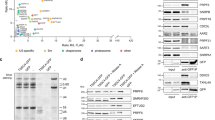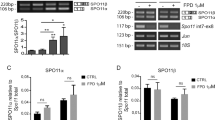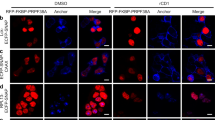Abstract
oskar RNA localization to the posterior pole of the Drosophila melanogaster oocyte requires splicing of the first intron and the exon junction complex (EJC) core proteins. The functional link between splicing, EJC deposition and oskar localization has been unclear. Here we demonstrate that the EJC associates with oskar mRNA upon splicing in vitro and that Drosophila EJC deposition is constitutive and conserved. Our in vivo analysis reveals that splicing creates the spliced oskar localization element (SOLE), whose structural integrity is crucial for ribonucleoprotein motility and localization in the oocyte. Splicing thus has a dual role in oskar mRNA localization: assembling the SOLE and depositing the EJC required for mRNA transport. The SOLE complements the EJC in formation of a functional unit that, together with the oskar 3′ UTR, maintains proper kinesin-based motility of oskar mRNPs and posterior mRNA targeting.
This is a preview of subscription content, access via your institution
Access options
Subscribe to this journal
Receive 12 print issues and online access
$189.00 per year
only $15.75 per issue
Buy this article
- Purchase on Springer Link
- Instant access to full article PDF
Prices may be subject to local taxes which are calculated during checkout






Similar content being viewed by others
References
Besse, F. & Ephrussi, A. Translational control of localized mRNAs: restricting protein synthesis in space and time. Nat. Rev. Mol. Cell Biol. 9, 971–980 (2008).
Martin, K.C. & Ephrussi, A. mRNA localization: gene expression in the spatial dimension. Cell 136, 719–730 (2009).
St Johnston, D. Moving messages: the intracellular localization of mRNAs. Nat. Rev. Mol. Cell Biol. 6, 363–375 (2005).
Pokrywka, N.J. & Stephenson, E.C. Microtubules are a general component of mRNA localization systems in Drosophila oocytes. Dev. Biol. 167, 363–370 (1995).
Brendza, R.P., Serbus, L.R., Duffy, J.B. & Saxton, W.M. A function for kinesin I in the posterior transport of oskar mRNA and Staufen protein. Science 289, 2120–2122 (2000).
Zimyanin, V.L. et al. In vivo imaging of oskar mRNA transport reveals the mechanism of posterior localization. Cell 134, 843–853 (2008).
Kim-Ha, J., Webster, P.J., Smith, J.L. & Macdonald, P.M. Multiple RNA regulatory elements mediate distinct steps in localization of oskar mRNA. Development 119, 169–178 (1993).
Hachet, O. & Ephrussi, A. Splicing of oskar RNA in the nucleus is coupled to its cytoplasmic localization. Nature 428, 959–963 (2004).
Mohr, S.E., Dillon, S.T. & Boswell, R.E. The RNA-binding protein Tsunagi interacts with Mago Nashi to establish polarity and localize oskar mRNA during Drosophila oogenesis. Genes Dev. 15, 2886–2899 (2001).
Hachet, O. & Ephrussi, A. Drosophila Y14 shuttles to the posterior of the oocyte and is required for oskar mRNA transport. Curr. Biol. 11, 1666–1674 (2001).
Newmark, P.A. & Boswell, R.E. The mago nashi locus encodes an essential product required for germ plasm assembly in Drosophila. Development 120, 1303–1313 (1994).
van Eeden, F.J., Palacios, I.M., Petronczki, M., Weston, M.J. & St Johnston, D. Barentsz is essential for the posterior localization of oskar mRNA and colocalizes with it to the posterior pole. J. Cell Biol. 154, 511–524 (2001).
Palacios, I.M., Gatfield, D., St Johnston, D. & Izaurralde, E. An eIF4AIII-containing complex required for mRNA localization and nonsense-mediated mRNA decay. Nature 427, 753–757 (2004).
Chan, C.C. et al. eIF4A3 is a novel component of the exon junction complex. RNA 10, 200–209 (2004).
Le Hir, H., Gatfield, D., Izaurralde, E. & Moore, M.J. The exon-exon junction complex provides a binding platform for factors involved in mRNA export and nonsense-mediated mRNA decay. EMBO J. 20, 4987–4997 (2001).
Kataoka, N. et al. Pre-mRNA splicing imprints mRNA in the nucleus with a novel RNA-binding protein that persists in the cytoplasm. Mol. Cell 6, 673–682 (2000).
Dreyfuss, G., Kim, V.N. & Kataoka, N. Messenger-RNA-binding proteins and the messages they carry. Nat. Rev. Mol. Cell Biol. 3, 195–205 (2002).
Ballut, L. et al. The exon junction core complex is locked onto RNA by inhibition of eIF4AIII ATPase activity. Nat. Struct. Mol. Biol. 12, 861–869 (2005).
Le Hir, H., Izaurralde, E., Maquat, L.E. & Moore, M.J. The spliceosome deposits multiple proteins 20–24 nucleotides upstream of mRNA exon-exon junctions. EMBO J. 19, 6860–6869 (2000).
Kataoka, N., Diem, M.D., Kim, V.N., Yong, J. & Dreyfuss, G. Magoh, a human homolog of Drosophila mago nashi protein, is a component of the splicing-dependent exon-exon junction complex. EMBO J. 20, 6424–6433 (2001).
Kim, V.N., Kataoka, N. & Dreyfuss, G. Role of the nonsense-mediated decay factor hUpf3 in the splicing-dependent exon-exon junction complex. Science 293, 1832–1836 (2001).
Cha, B.J., Serbus, L.R., Koppetsch, B.S. & Theurkauf, W.E. Kinesin I–dependent cortical exclusion restricts pole plasm to the oocyte posterior. Nat. Cell Biol. 4, 592–598 (2002).
González-Reyes, A., Elliott, H. & St Johnston, D. Polarization of both major body axes in Drosophila by gurken-torpedo signalling. Nature 375, 654–658 (1995).
Roth, S., Neuman-Silberberg, F.S., Barcelo, G. & Schupbach, T. cornichon and the EGF receptor signaling process are necessary for both anterior-posterior and dorsal-ventral pattern formation in Drosophila. Cell 81, 967–978 (1995).
Jambhekar, A. & Derisi, J.L. Cis-acting determinants of asymmetric, cytoplasmic RNA transport. RNA 13, 625–642 (2007).
Daigle, N. & Ellenberg, J. LambdaN-GFP: an RNA reporter system for live-cell imaging. Nat. Methods 4, 633–636 (2007).
Herold, N. et al. Conservation of the protein composition and electron microscopy structure of Drosophila melanogaster and human spliceosomal complexes. Mol. Cell. Biol. 29, 281–301 (2009).
Saulière, J. et al. The exon junction complex differentially marks spliced junctions. Nat. Struct. Mol. Biol. 17, 1269–1271 (2010).
Loiseau, P., Davies, T., Williams, L.S., Mishima, M. & Palacios, I.M. Drosophila PAT1 is required for Kinesin-1 to transport cargo and to maximize its motility. Development 137, 2763–2772 (2010).
Welte, M.A., Gross, S.P., Postner, M., Block, S.M. & Wieschaus, E.F. Developmental regulation of vesicle transport in Drosophila embryos: forces and kinetics. Cell 92, 547–557 (1998).
Navarro, C., Puthalakath, H., Adams, J.M., Strasser, A. & Lehmann, R. Egalitarian binds dynein light chain to establish oocyte polarity and maintain oocyte fate. Nat. Cell Biol. 6, 427–435 (2004).
MacDonald, P.M. bicoid mRNA localization signal: phylogenetic conservation of function and RNA secondary structure. Development 110, 161–171 (1990).
Cohen, R.S., Zhang, S. & Dollar, G.L. The positional, structural, and sequence requirements of the Drosophila TLS RNA localization element. RNA 11, 1017–1029 (2005).
Bullock, S.L., Ringel, I., Ish-Horowicz, D. & Lukavsky, P.J. A′-form RNA helices are required for cytoplasmic mRNA transport in Drosophila. Nat. Struct. Mol. Biol. 17, 703–709 (2010).
Juhn, J. & James, A.A. oskar gene expression in the vector mosquitoes, Anopheles gambiae and Aedes aegypti. Insect Mol. Biol. 15, 363–372 (2006).
Juhn, J., Marinotti, O., Calvo, E. & James, A.A. Gene structure and expression of nanos (nos) and oskar (osk) orthologues of the vector mosquito, Culex quinquefasciatus. Insect Mol. Biol. 17, 545–552 (2008).
Goltsev, Y., Hsiong, W., Lanzaro, G. & Levine, M. Different combinations of gap repressors for common stripes in Anopheles and Drosophila embryos. Dev. Biol. 275, 435–446 (2004).
Horne-Badovinac, S. & Bilder, D. Dynein regulates epithelial polarity and the apical localization of stardust A mRNA. PLoS Genet. 4, e8 (2008).
Horton, R.M., Hunt, H.D., Ho, S.N., Pullen, J.K. & Pease, L.R. Engineering hybrid genes without the use of restriction enzymes: gene splicing by overlap extension. Gene 77, 61–68 (1989).
Rio, D.C. Accurate and efficient pre-mRNA splicing in Drosophila cell-free extracts. Proc. Natl. Acad. Sci. USA 85, 2904–2908 (1988).
Marchand, V. et al. Identification of protein partners of the human immunodeficiency virus 1 tat/rev exon 3 leads to the discovery of a new HIV-1 splicing regulator, protein hnRNP K. RNA Biol. 8, 325–342 (2011).
Nekrasov, M. et al. Pcl-PRC2 is needed to generate high levels of H3-K27 trimethylation at Polycomb target genes. EMBO J. 26, 4078–4088 (2007).
Prasad, M., Jang, A.C., Starz-Gaiano, M., Melani, M. & Montell, D.J. A protocol for culturing Drosophila melanogaster stage 9 egg chambers for live imaging. Nat. Protoc. 2, 2467–2473 (2007).
Acknowledgements
We thank H. Le Hir (Institut de Biologie de l'Ecole Normale Supérieure, Paris, France) for his gift of TAP-tagged EJC proteins; R. Lührmann (Max-Planck-Institut für Biophysikalische Chemie, Göttingen, Germany) and D. Rio (University of California, Berkeley, USA) for Kc cell nuclear extracts; J. Ellenberg (the European Molecular Biology Laboratory (EMBL), Heidelberg, Germany) for the gift of λN-GFP and boxB reporter vectors; D. St Johnston (The Wellcome Trust, Cancer Research UK Gurdon Institute, Cambridge, UK) for the oskMS2-GFP; D. Brunner (Institute of Molecular Life Sciences, University of Zürich, Switzerland) for the UASp-EB1-mCherry fly stocks; the EMBL GeneCore Facility for DNA sequencing, the EMBL Advanced Light Microscopy Facility for the use of microscopes, and A.-M. Voie and S. Müller for fly transgenesis. We also thank A. Cyrklaff for assistance with embryo collection, S.-J. Fan for the gift of the pUASpλN-GFP plasmid, M. Jeske for inspiration in naming of transgenes, A. Obrdlik, M. Hentze and I. Telley for critical discussions and comments on the manuscript. S.G. was supported in part by a Deutsche Forschungsgemeinschaft SPP grant (DFG EP 37/1-3) to A.E.; V.M. by a fellowship from the Fondation pour la Recherche Médicale; and I.G. by an EMBL Interdisciplinary Postdoctoral fellowship (EIPOD) and an EMBO Long-term Fellowship.
Author information
Authors and Affiliations
Contributions
S.G. generated the transgenes and carried out all aspects of the in situ analysis of mRNA localization. V.M. generated Drosophila embryo nuclear extracts, established the in vitro splicing assay, and performed the RNase protection experiments and immunoprecipitations. I.G. performed the time-lapse imaging of live oocytes and the statistical analyses. S.G., V.M., I.G. and A.E. conceived the experiments, analyzed the data and wrote the manuscript.
Corresponding author
Ethics declarations
Competing interests
The authors declare no competing financial interests.
Supplementary information
Supplementary Text and Figures
Supplementary Figures 1–7, Supplementary Tables 1–3 and Supplementary Methods (PDF 14024 kb)
Supplementary Video 1
Motility of oskΔi(2,3) RNPs in living stage-9 oocyte (AVI 4849 kb)
Supplementary Video 2
Motility of oskMS2 RNPs in living stage-9 oocyte (AVI 4744 kb)
Supplementary Video 3
Motility of colchicine treated oskΔi(2,3) RNPs in living stage 9 oocyte (AVI 4814 kb)
Supplementary Video 4
Motility of oskΔi(1,2,3) RNPs in living stage-9 oocyte (AVI 4836 kb)
Supplementary Video 5
Motility of oskPSLz RNPs in living stage-9 oocyte (AVI 4864 kb)
Supplementary Video 6
Motility of oskPSLzc RNPs in living stage-9 oocyte (AVI 3502 kb)
Supplementary Video 7
Viability and development of a dissected stage 8-9 egg chamber expressing oskΔi(2,3)*GFP (AVI 10803 kb)
Rights and permissions
About this article
Cite this article
Ghosh, S., Marchand, V., Gáspár, I. et al. Control of RNP motility and localization by a splicing-dependent structure in oskar mRNA. Nat Struct Mol Biol 19, 441–449 (2012). https://doi.org/10.1038/nsmb.2257
Received:
Accepted:
Published:
Issue Date:
DOI: https://doi.org/10.1038/nsmb.2257
This article is cited by
-
Comprehensive mapping of exon junction complex binding sites reveals universal EJC deposition in Drosophila
BMC Biology (2023)
-
Subcellular spatial transcriptomics identifies three mechanistically different classes of localizing RNAs
Nature Communications (2022)
-
Exon Junction Complexes can have distinct functional flavours to regulate specific splicing events
Scientific Reports (2018)
-
Exon junction complex (EJC) core genes play multiple developmental roles in Physalis floridana
Plant Molecular Biology (2018)
-
Two highly similar DEAD box proteins, OsRH2 and OsRH34, homologous to eukaryotic initiation factor 4AIII, play roles of the exon junction complex in regulating growth and development in rice
BMC Plant Biology (2016)



